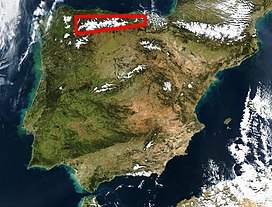Cantabrian Mountains
| Cantabrian Mountains | |
|---|---|
| Spanish: Cordillera Cantábrica | |

The Picos de Europa typical Cantabrian Mountains landscape overlooking the village of Sotres, Cabrales
|
|
| Highest point | |
| Peak | Torre de Cerredo |
| Elevation | 2,648 m (8,688 ft) |
| Coordinates | 43°11′51″N 04°51′06″W / 43.19750°N 4.85167°W |
| Dimensions | |
| Length | 300 km (190 mi) WE |
| Width | 50 km (31 mi) NS |
| Naming | |
| Etymology | Cantabria |
| Geography | |
| Country | Spain |
| Communities |
Basque Country, Castile and León, Cantabria, Asturias |
| Range coordinates | 43°N 5°W / 43°N 5°WCoordinates: 43°N 5°W / 43°N 5°W |
| Borders on | Pyrenees and Galicia |
| Geology | |
| Age of rock | Carboniferous, Paleozoic, Mesozoic |
| Type of rock | Limestone |
The Cantabrian Mountains or Cantabrian Range (Spanish: Cordillera Cantábrica) are one of the main systems of mountain ranges in Spain. They stretch for over 300 km (180 miles) across northern Spain, from the western limit of the Pyrenees to the Galician Massif in Galicia, along the coast of the Cantabrian Sea. Their easternmost end meets the Sistema Ibérico.
These mountains are a distinct physiographic province of the larger Alpine System physiographic division.
The Cantabrian Mountains offer a wide range of trails for hiking, as well as many challenging climbing routes. Skiing is possible in the ski resorts of Alto Campoo, Valgrande-Pajares and Manzaneda.
The Cantabrian Mountains stretch east-west, nearly parallel to the sea, as far as the pass of Leitariegos, also extending south between León and Galicia. The range's western boundary is marked by the valley of the river Miño (Portuguese: Minho), by the lower Sil, which flows into the Miño, and by the Cabrera River, a small tributary of the Sil. Cantabrian mountains reach its south-western limit in Portugal.
As a whole, the Cantabrian Mountains are remarkable for their intricate ramifications, but almost everywhere, and especially in the east, it is possible to distinguish two principal ranges, from which the lesser ridges and mountain masses radiate. One range, or series of ranges, closely follows the outline of the coast; the other, which is loftier, forms the northern limit of the great tableland of Castile and León, and is sometimes regarded as a continuation of the Pyrenees. In some parts the coastal range rises sheer above the sea, and everywhere has so abrupt a declivity that the streams which flow seaward are all short and swift.
...
Wikipedia

